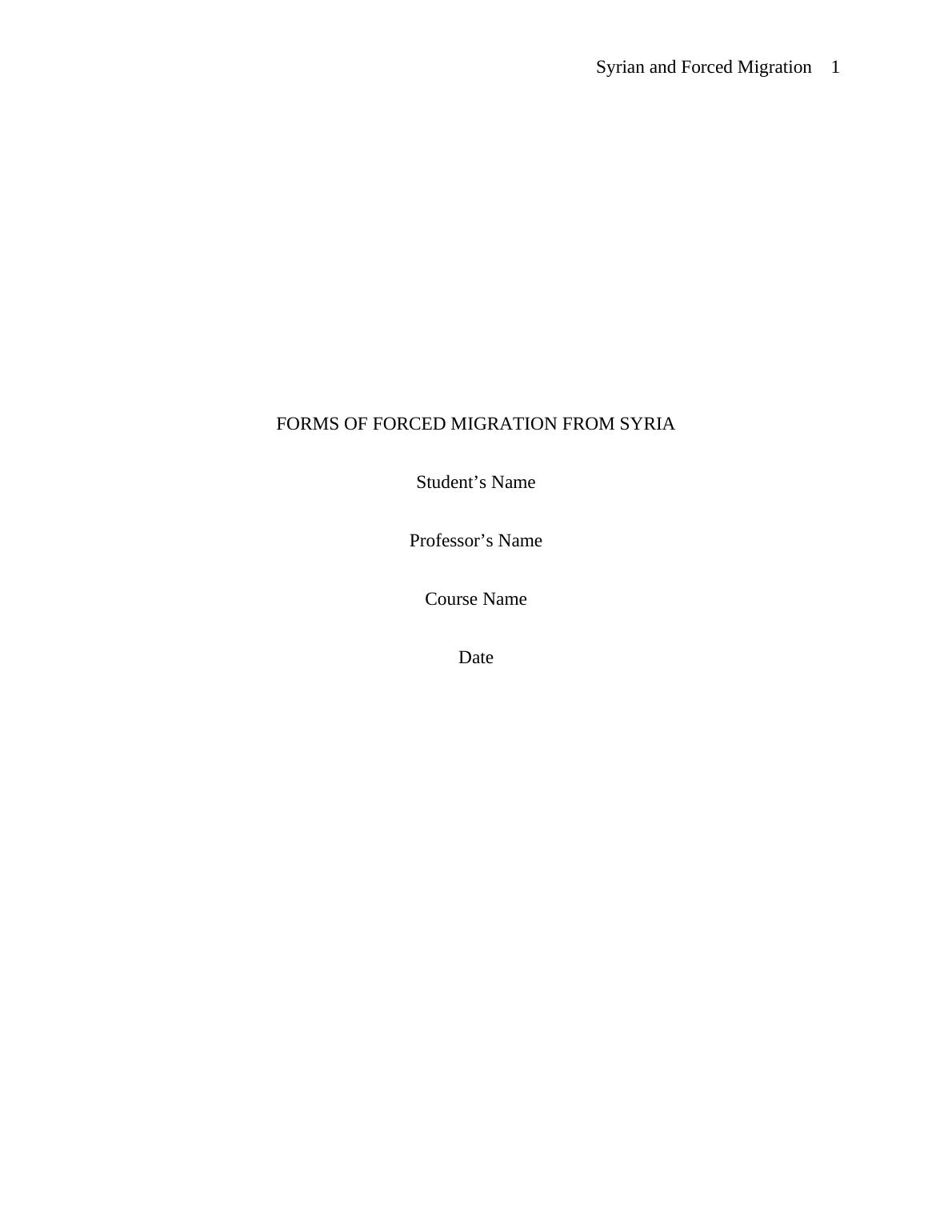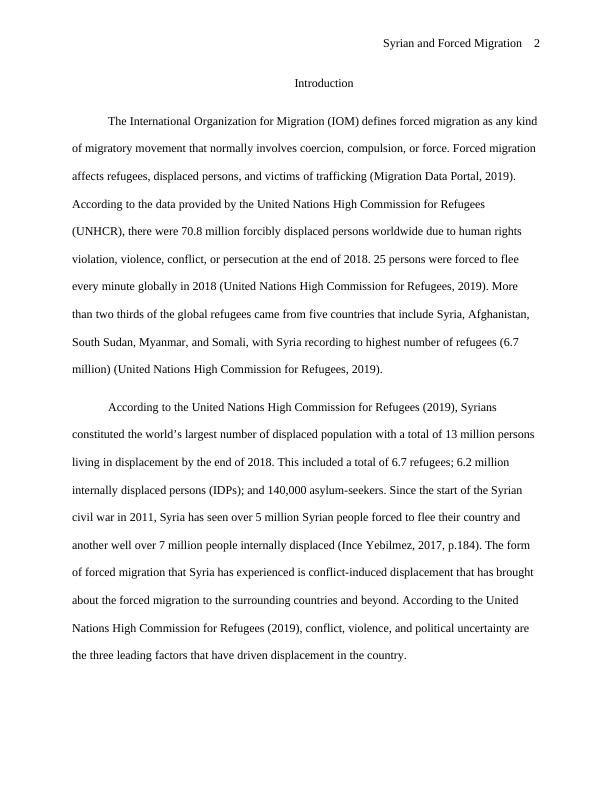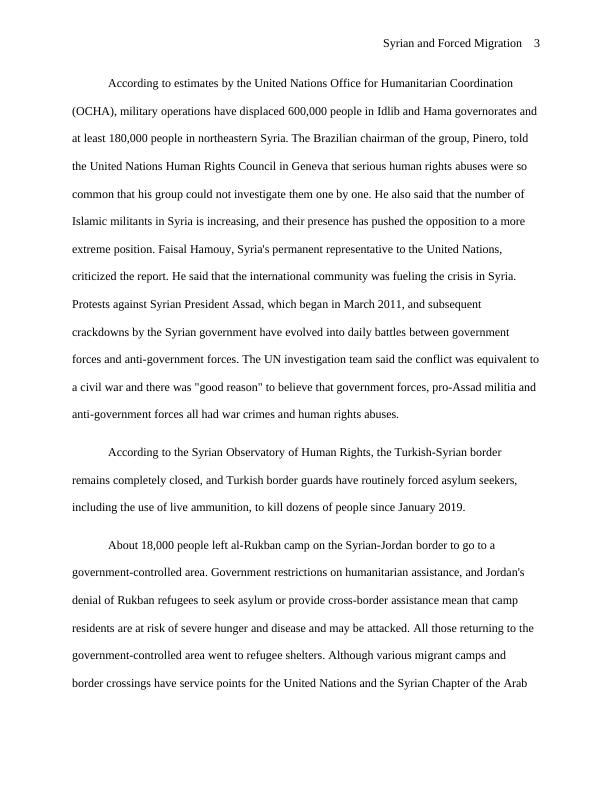Syrian and Forced Migration
Added on 2022-08-15
13 Pages3460 Words27 Views
Syrian and Forced Migration 1
FORMS OF FORCED MIGRATION FROM SYRIA
Student’s Name
Professor’s Name
Course Name
Date
FORMS OF FORCED MIGRATION FROM SYRIA
Student’s Name
Professor’s Name
Course Name
Date

Syrian and Forced Migration 2
Introduction
The International Organization for Migration (IOM) defines forced migration as any kind
of migratory movement that normally involves coercion, compulsion, or force. Forced migration
affects refugees, displaced persons, and victims of trafficking (Migration Data Portal, 2019).
According to the data provided by the United Nations High Commission for Refugees
(UNHCR), there were 70.8 million forcibly displaced persons worldwide due to human rights
violation, violence, conflict, or persecution at the end of 2018. 25 persons were forced to flee
every minute globally in 2018 (United Nations High Commission for Refugees, 2019). More
than two thirds of the global refugees came from five countries that include Syria, Afghanistan,
South Sudan, Myanmar, and Somali, with Syria recording to highest number of refugees (6.7
million) (United Nations High Commission for Refugees, 2019).
According to the United Nations High Commission for Refugees (2019), Syrians
constituted the world’s largest number of displaced population with a total of 13 million persons
living in displacement by the end of 2018. This included a total of 6.7 refugees; 6.2 million
internally displaced persons (IDPs); and 140,000 asylum-seekers. Since the start of the Syrian
civil war in 2011, Syria has seen over 5 million Syrian people forced to flee their country and
another well over 7 million people internally displaced (Ince Yebilmez, 2017, p.184). The form
of forced migration that Syria has experienced is conflict-induced displacement that has brought
about the forced migration to the surrounding countries and beyond. According to the United
Nations High Commission for Refugees (2019), conflict, violence, and political uncertainty are
the three leading factors that have driven displacement in the country.
Introduction
The International Organization for Migration (IOM) defines forced migration as any kind
of migratory movement that normally involves coercion, compulsion, or force. Forced migration
affects refugees, displaced persons, and victims of trafficking (Migration Data Portal, 2019).
According to the data provided by the United Nations High Commission for Refugees
(UNHCR), there were 70.8 million forcibly displaced persons worldwide due to human rights
violation, violence, conflict, or persecution at the end of 2018. 25 persons were forced to flee
every minute globally in 2018 (United Nations High Commission for Refugees, 2019). More
than two thirds of the global refugees came from five countries that include Syria, Afghanistan,
South Sudan, Myanmar, and Somali, with Syria recording to highest number of refugees (6.7
million) (United Nations High Commission for Refugees, 2019).
According to the United Nations High Commission for Refugees (2019), Syrians
constituted the world’s largest number of displaced population with a total of 13 million persons
living in displacement by the end of 2018. This included a total of 6.7 refugees; 6.2 million
internally displaced persons (IDPs); and 140,000 asylum-seekers. Since the start of the Syrian
civil war in 2011, Syria has seen over 5 million Syrian people forced to flee their country and
another well over 7 million people internally displaced (Ince Yebilmez, 2017, p.184). The form
of forced migration that Syria has experienced is conflict-induced displacement that has brought
about the forced migration to the surrounding countries and beyond. According to the United
Nations High Commission for Refugees (2019), conflict, violence, and political uncertainty are
the three leading factors that have driven displacement in the country.

Syrian and Forced Migration 3
According to estimates by the United Nations Office for Humanitarian Coordination
(OCHA), military operations have displaced 600,000 people in Idlib and Hama governorates and
at least 180,000 people in northeastern Syria. The Brazilian chairman of the group, Pinero, told
the United Nations Human Rights Council in Geneva that serious human rights abuses were so
common that his group could not investigate them one by one. He also said that the number of
Islamic militants in Syria is increasing, and their presence has pushed the opposition to a more
extreme position. Faisal Hamouy, Syria's permanent representative to the United Nations,
criticized the report. He said that the international community was fueling the crisis in Syria.
Protests against Syrian President Assad, which began in March 2011, and subsequent
crackdowns by the Syrian government have evolved into daily battles between government
forces and anti-government forces. The UN investigation team said the conflict was equivalent to
a civil war and there was "good reason" to believe that government forces, pro-Assad militia and
anti-government forces all had war crimes and human rights abuses.
According to the Syrian Observatory of Human Rights, the Turkish-Syrian border
remains completely closed, and Turkish border guards have routinely forced asylum seekers,
including the use of live ammunition, to kill dozens of people since January 2019.
About 18,000 people left al-Rukban camp on the Syrian-Jordan border to go to a
government-controlled area. Government restrictions on humanitarian assistance, and Jordan's
denial of Rukban refugees to seek asylum or provide cross-border assistance mean that camp
residents are at risk of severe hunger and disease and may be attacked. All those returning to the
government-controlled area went to refugee shelters. Although various migrant camps and
border crossings have service points for the United Nations and the Syrian Chapter of the Arab
According to estimates by the United Nations Office for Humanitarian Coordination
(OCHA), military operations have displaced 600,000 people in Idlib and Hama governorates and
at least 180,000 people in northeastern Syria. The Brazilian chairman of the group, Pinero, told
the United Nations Human Rights Council in Geneva that serious human rights abuses were so
common that his group could not investigate them one by one. He also said that the number of
Islamic militants in Syria is increasing, and their presence has pushed the opposition to a more
extreme position. Faisal Hamouy, Syria's permanent representative to the United Nations,
criticized the report. He said that the international community was fueling the crisis in Syria.
Protests against Syrian President Assad, which began in March 2011, and subsequent
crackdowns by the Syrian government have evolved into daily battles between government
forces and anti-government forces. The UN investigation team said the conflict was equivalent to
a civil war and there was "good reason" to believe that government forces, pro-Assad militia and
anti-government forces all had war crimes and human rights abuses.
According to the Syrian Observatory of Human Rights, the Turkish-Syrian border
remains completely closed, and Turkish border guards have routinely forced asylum seekers,
including the use of live ammunition, to kill dozens of people since January 2019.
About 18,000 people left al-Rukban camp on the Syrian-Jordan border to go to a
government-controlled area. Government restrictions on humanitarian assistance, and Jordan's
denial of Rukban refugees to seek asylum or provide cross-border assistance mean that camp
residents are at risk of severe hunger and disease and may be attacked. All those returning to the
government-controlled area went to refugee shelters. Although various migrant camps and
border crossings have service points for the United Nations and the Syrian Chapter of the Arab

Syrian and Forced Migration 4
Red Crescent Society, reports indicate that evacuees were detained and ill-treated after reaching
government-controlled areas.
Despite serious security risks and opaque conditions in the Syrian government-controlled
areas, Syrian refugees staying in surrounding countries are still under pressure from host
countries to return to Syria. According to UNHCR records, as of June 2019, more than 40,000
refugees have returned.
In Turkey, more than 3.6 million Syrian refugees have been temporarily protected, and
Istanbul alone has accommodated 500,000. But in 2019, after the Turkish authorities forced them
to sign a "voluntary return" form, many of them were detained and forcibly repatriated. Many
eventually arrived in the Sharm Liberation Organization-controlled area of Idlib Province, either
arrested by the organization or attacked by Syrian-Russian coalition forces.
Turkey also proposes to establish a buffer zone in northeastern Syria and plans to relocate
at least 1 million Syrians in Turkey. However, the establishment of a buffer zone may not ensure
the protection of civilians and may lead to many human rights issues.
Lebanon has hosted about 1.5 million Syrian refugees, but since April they have been
strongly encouraged to return and take active measures to curb the influx of refugees. The
General Directorate of Security of the Lebanese Border Control Agency (General Security) said
that after making a decision on May 13, 2019 to expel all Syrians who entered the country
illegally after April 24, the agency has been operating from May 21 to August 28. 2,731 Syrians
were deported and handed directly to Syrian authorities . At least three deportees were arrested
by Syrian authorities on their return.
U.S. support forces and U.S.-led coalition violate human rights
Red Crescent Society, reports indicate that evacuees were detained and ill-treated after reaching
government-controlled areas.
Despite serious security risks and opaque conditions in the Syrian government-controlled
areas, Syrian refugees staying in surrounding countries are still under pressure from host
countries to return to Syria. According to UNHCR records, as of June 2019, more than 40,000
refugees have returned.
In Turkey, more than 3.6 million Syrian refugees have been temporarily protected, and
Istanbul alone has accommodated 500,000. But in 2019, after the Turkish authorities forced them
to sign a "voluntary return" form, many of them were detained and forcibly repatriated. Many
eventually arrived in the Sharm Liberation Organization-controlled area of Idlib Province, either
arrested by the organization or attacked by Syrian-Russian coalition forces.
Turkey also proposes to establish a buffer zone in northeastern Syria and plans to relocate
at least 1 million Syrians in Turkey. However, the establishment of a buffer zone may not ensure
the protection of civilians and may lead to many human rights issues.
Lebanon has hosted about 1.5 million Syrian refugees, but since April they have been
strongly encouraged to return and take active measures to curb the influx of refugees. The
General Directorate of Security of the Lebanese Border Control Agency (General Security) said
that after making a decision on May 13, 2019 to expel all Syrians who entered the country
illegally after April 24, the agency has been operating from May 21 to August 28. 2,731 Syrians
were deported and handed directly to Syrian authorities . At least three deportees were arrested
by Syrian authorities on their return.
U.S. support forces and U.S.-led coalition violate human rights

End of preview
Want to access all the pages? Upload your documents or become a member.
Related Documents
Analyzing Syrian Refugee Crisislg...
|12
|3282
|103
Let Them In! Campaign for Syrian Refugees in Tunisialg...
|8
|2026
|326
Creation of International Criminal Tribunal for Crimes Committed by ISIS in Iraq and Syrialg...
|10
|2265
|243
Asylum Seekers and Refugees in Australialg...
|14
|4449
|69
Research on Syria Refugee Crisislg...
|14
|3595
|360
Summary and Strong Responselg...
|4
|532
|88
